




Editor-in-Chief
About 100 people gathered outside the Philadelphia Field Office of U.S. Immigration and Customs Enforcement Nov. 13 for a public witness event in support of immigrant and migrant communities.
The event was part of the nationwide “One Church, One Family” campaign, which calls Catholics to “reject the culture of fear and silence that dehumanizes” and to “stand with migrants,” according to the campaign’s website. Campaign partners included the Jesuits of the USA East and West Provinces, the Ignatian Solidarity Network and the Jesuit Refugee Service USA, among others.
The Nov. 13 event, one of 68 across the nation held that same day, coincided with the feast day of St. Frances Xavier Cabrini, patron saint of immigrants. Cabrini was an Italian immigrant and the first U.S. citizen to be canonized. The campaign sponsored a similar event Oct. 22.
Individuals sang and prayed in English and Spanish, processed in silence around the block while following the Eucharist and held signs with messages of unity and solidarity. Messages included “The Holy Family were forced to flee, too” and “Build bridges, not walls,” a reference to a statement issued Oct. 31, 2024, by the late Pope Francis about community.
“We are to welcome the stranger, welcome our neighbors, welcome migrants and integrate them into our communities because we are ‘one church, one family,’” said Andrew Hanson-Quintana, an organizer of the campaign and director of communications for the Ignatian Solidarity Network.
A rise in arrests and detention
Since President Donald Trump took office Jan. 20, arrests by ICE have doubled, and the number of individuals being detained is at an all-time high. As of Sept. 21, there were 59,762 individuals in ICE detention.
In Pennsylvania, New Jersey and Delaware, ICE arrested 4,969 people between Jan. 20 and June 26. In the Philadelphia area, raids have occurred at locations like a park in the Whitman neighborhood and the Super Gigante food market in West Norriton.
Over 4-in-10 American Catholics are immigrants or the children of immigrants, according to data from the Pew Research Center. Of this group, the majority are Asian Catholics and Hispanic Catholics.
Across the nation, people are “being brutalized and aggressively attacked, either for being an immigrant, having the observable characteristics of one, as the Supreme Court said, or standing up for them,” said Sister Michelle Cimaroli of the Handmaids of the Sacred Heart of Jesus, who spoke at the event.
“We hear of people trying to follow the rules set forth by our government, to appear in court and at check-ins here in this building right behind us, only to have their lives and the lives of their children violently disrupted, often with permanent effect,” Cimaroli told the crowd. “It all forces people — the children of God — to live in constant fear.”
Standing ‘in solidarity and kinship’ Nationwide, individuals have mobilized to protest the mass detention and deportation of migrant communities, with
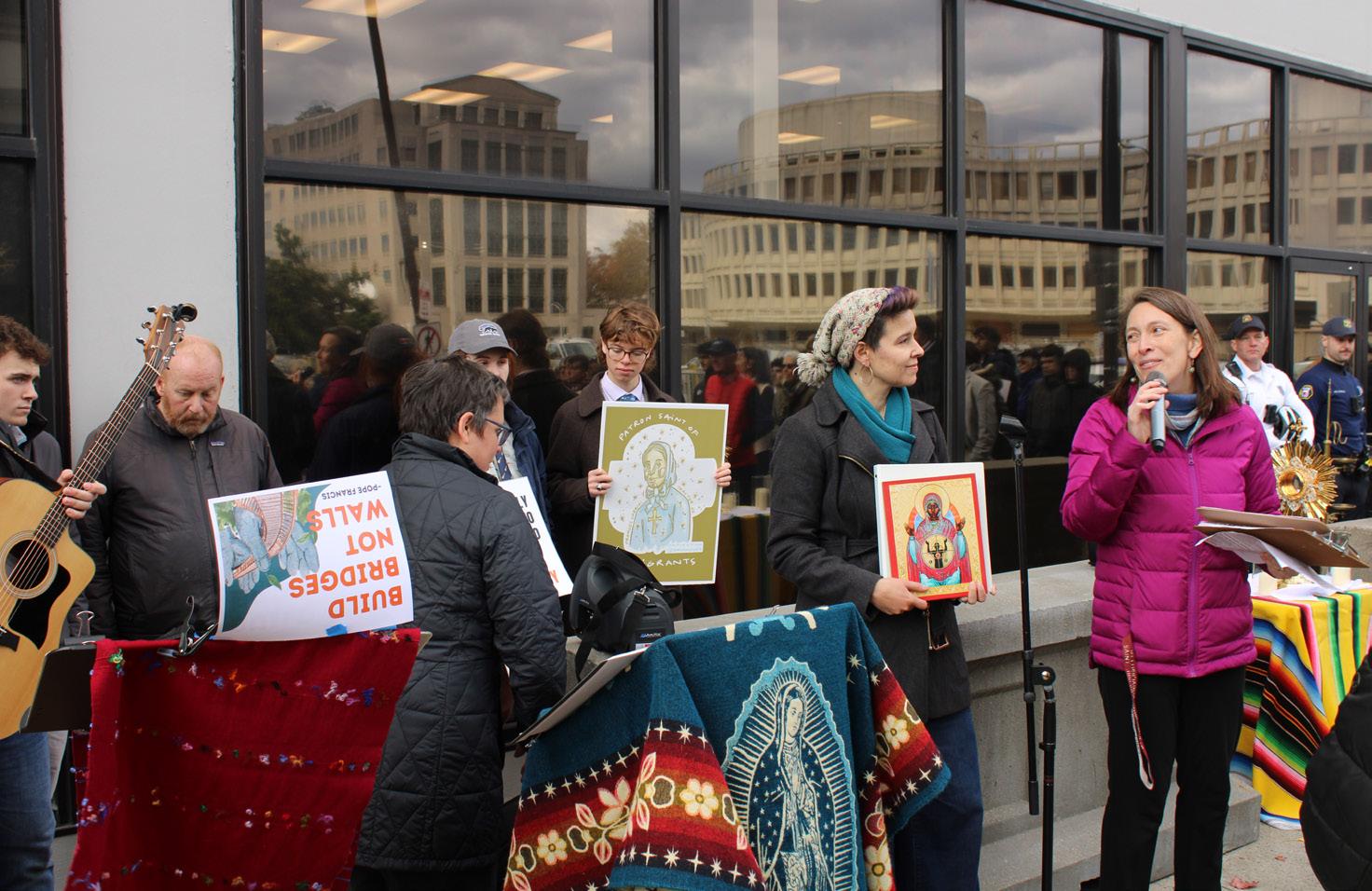
concerns rising over the increased use of force by ICE agents. In addition to secular protests, religious groups have organized rallies and vigils. Some individuals — like seven faith leaders at a Nov. 14 multifaith service outside the Broadview ICE facility in Illinois — were arrested.
Mary Gay Scanlon, U.S. representative for Pennsylvania’s 5th congressional district who attended the gathering in Philadelphia, described the treatment of migrants as “inhumane.” Scanlon was one of several members of Congress who attended an Oct. 24 shadow congressional hearing in Chicago that examined the impacts of ICE raids on the local community.
“Our system has long been broken, but what we’re seeing under this administration is truly horrific — the dehumanization of people, the vilification of our neighbors,”
Scanlon said.
People of all ages attended the gathering, including a cohort of students from St. Joseph’s Preparatory School. In addition to carrying signs, students held images, such as a painting depicting Our Lady of Guadalupe — an apparition of the Virgin Mary in 16th century Mexico.
Matt Shields ’27, a St. Joseph’s Preparatory School alum, emphasized the role of youth in standing up for immigration justice. Shields grew passionate about immigration justice after going on an immersion trip to the Rio Grande Valley in Texas in high school and spending time at border camps.
“PUBLIC WITNESS”

‘An invitation to embody that clarity as a moral voice’
“When young people show up, I think it shows it’s an intergenerational struggle, and it’s something that resonates with people of all different backgrounds, all different ages, all different levels of education, socioeconomic status,” Shields said. “It is universal, the struggle and people’s ability to stand in solidarity and kinship with others and recognize where there is injustice.”
A commitment to social justice
The Catholic Church’s stance on immigration, based on Scripture, Catholic Social Teaching and statements by leaders, “couldn’t be more clear,” Hanson-Quintana said.
“This is an invitation to embody that clarity as a moral voice in our communities, to say, ‘This is what Catholics believe, and what’s happening in our country is not moral according to where we stand and our faith tradition,’” Hanson-Quintana said.
Church leaders internationally have
reiterated the church’s stance on immigration over recent months. Pope Leo XIV — a descendant of immigrants — described the treatment of migrants as “not the legitimate exercise of national sovereignty, but rather grave crimes committed or tolerated by the state.”
The United States Conference of Catholic Bishops issued a “Special Message” Nov. 12 denouncing mass deportations, dehumanizing rhetoric and the vilification of immigrants. The message, which was read aloud at the gathering, was the first special message issued since 2013.
Marcelle McGuirk, a representative of the Archdiocese of Philadelphia and chair of the Archbishop’s Commission for Racial Healing, said individuals should “go beyond just talking about it on social media” and stand in solidarity with the oppressed.
“I think getting ourselves seen and seeing that witness more publicly is really important to remind our nation where the
Church stands on these issues,” McGuirk said.
Sharoon Negrete González, a parishioner of St. Vincent de Paul Church in Germantown, said she hoped those entering the Philadelphia ICE office felt the crowd standing “alongside” them. Negrete González encouraged people to go beyond their “comfort zone” to make change in their communities.
“I would love for [prayer] to not only be a thing that we do every Sunday but for people to find their closest food bank, to find their closest homeless shelter,” Negrete González said. “There’s so many ways in which they can be witnesses in their everyday life.”
Sister Florence Enechukwu, a Missionary Sister of the Holy Rosary and director of the African Catholic Apostolate in the Archbishop’s Commission for Racial Healing, said God created people to be unified as one, “no matter the nationality, no matter the culture, no matter the creed.”
“That’s what we are here for, to support each other, to support those who have been taken away from us, from our community,” Enechukwu said.
This is the second article in a series by Hannah Pajtis ’26 that highlights immigration-related stories from the Philadelphia area.
The Women’s Center announced Nov. 6 it has been rebanded as the Alumnae Center for Leadership. The Alumnae Center will continue to support the Women’s Center’s initiatives, like Operation Tampon and the Career Closet, through Cura Collective, an initiative under the Alumnae Center.
The center’s name change reflects the university’s desire to engage more with St. Joe’s alumnae, who make up over half of the university’s 112,000 living alums, wrote Becki Scola, Ph.D., associate provost for the Office of Inclusive Excellence and Institutional Effectiveness, in an email to The Hawk.
The center’s inaugural year will be directed by Mary Lou Quinlan ’75, H ’07. Cura Collective serves as “the service
and resource arm” of the Alumnae Center, Scola said. In addition, HawkHUB, St. Joe’s food and basic needs resource center, will also now fall under Cura Collective’s umbrella.
This shift to Cura Collective embodies the Jesuit value the name represents: cura personalis, or “care for the whole person,” according to Nikki Sunnen, Ph.D., faculty liaison for Cura Collective.
Scola said the value of cura personalis is evident in the work Cura Collective does.
“It strives to be an inclusive, empowering source of services, support, education and resources for all members of the SJU community,” Scola said.
The Women’s Center was officially established by the Commission on the Status of Women in 1992, spearheaded by a subcommittee of students with the goal of providing resources and education about gender issues on campus.

In more recent years, the Women’s Center became home to Operation Tampon and the Career Closet. Operation Tampon began in the spring 2021 semester as a joint initiative between HawkHUB and the Women’s Leadership Initiative to begin providing free menstrual products in bathrooms on campus. In the fall of the same year, the Career Closet opened, supplying members of the St. Joe’s community with free professional attire.
Anjana Mosakowski ’27, student manager of the Cura Collective, said the new name maintains the organization’s mission while widening its reach on campus.
“I think, for me, it means that we get to do the same exact work that we’re doing, but we get to also be more inclusive and possibly, hopefully, expand and reach a wider audience of people,” Mosakowski said.
Madeline DeMarco ’22, M.S. ’23, former student liaison for the Women’s Center, played a big role in the formation of these initiatives. During her time at St. Joe’s, DeMarco served as co-president of WLI and president of HawkHUB, which she founded in the fall of 2019 and officially opened in the fall of 2020.
DeMarco said the driving force behind these projects was a “commitment to equity” and her “stubborn impatience.” There were things that kept her up at night, she said: food insecurity and access to menstrual products and professional clothing, to name a few.
“When no one could respond to my questions, I created the answers, and I tried to do my part in filling in the gaps,” DeMarco wrote in an email to The Hawk. “Thus born HawkHUB, Operation Tampon and the Career Closet, my own answers to the questions that kept me up at night.”
While Cura Collective’s mission is similar
to the Women’s Center’s gender-inclusive mission, Sunnen said the new name reaffirms that the services are not only centered around women.
“The initiatives we’ve been doing — Operation Tampon, Career Closet — those serve the whole community, and they’re not just for women,” Sunnen said. “I really like the tagline, so to speak, that the Alumnae Center for Leadership has: It’s ‘built for women, designed for all.’”
Providing these resources helps to ensure that all students are able to succeed and thrive, DeMarco said.
“For those who experience food and/or basic need insecurity, it impacts their health, academic success and overall well-being,” DeMarco said. “Access to these resources helps fill in gaps left by inequity and systemic injustices. When people don’t have access to meals, housing/clothing essentials or hygiene products, the stress of meeting their needs competes with their ability to learn, focus and thrive.”
Mosakowski reflected on the significance behind the new name and said she hoped students felt welcome in the space.
“I hope that they feel that it truly is a collective and that it truly is an effort to work together and a space to be included and inclusive also,” Mosakowski said. “I just want everyone to feel comfortable within that space and feel like they have that space for themselves.”

Editor
Detectives are close to a breakthrough in an investigation into approximately 28 student vehicle break-ins near St. Joe’s Hawk Hill campus that were reported from Nov. 4 to about Nov. 8, according to the Philadelphia Police Southwest Detective Division.
“I have two detectives assigned to the case who are working hard, and hopefully we’re going to be able to bring this to a conclusion by the end of the week,” said Captain Robert McKeever, commanding officer of the Southwest Detective Division.
The Office of Public Safety & Security alerted the St. Joe’s community in a Nov. 4 email that several vehicles “in and around Hawks’ Landing” were vandalized around 1 a.m. on the Hawk Hill campus. The message noted that “no one was hurt,” and Public Safety was “working with local police to investigate.”
Reported locations where cars were targeted include Hawks’ Landing, the Lannon Hall and Rashford Hall parking lots, the area surrounding Moore Hall and along 63rd Street near The Elm apartments, according to Brandon Pasquale, director of Public Safety. Pasquale said the incidents have been occurring “in clusters.”
The Philadelphia Police Southwest Detective Division — which encompasses the 12th, 16th, 18th and 19th districts of Philadelphia, according to McKeever — has been investigating the incidents. McKeever said the division reviewed video footage
of two individuals in a “dark SUV type, possibly a Kia or a Hyundai.”
“With the help of our partners from Lower Merion using their automatic license plate rear, we were able to track that vehicle to all the locations, and we believe we tracked them to another part of the city, which is still part of our investigation,” McKeever said.
Pasquale said while there are no issues with the campus security camera systems, not every camera may have been online at the time of the incidents. However, the footage from the cameras that were online provided usable information.
Campus patrols operate through six designated patrol zones determined by campus roadways and topography with the goal of assigning one officer to each zone during an eight-hour shift, Pasquale said. Staffing usually determines if zones can be combined for officers to patrol. All patrols are on foot, and have been increased in areas where the break-ins occurred.
Bailey Foller-Moll ’28 was going on a run Nov. 5 when she got a text from her mom, who had seen the initial alert, urging her to check on her 2012 Toyota RAV4 on the 3rd floor of Hawks’ Landing. Foller-Moll found the side passenger window of her car smashed in and the interior rummaged through. Nothing was taken besides her parking pass.
After Foller-Moll and a Public Safety officer waited for more than two hours for the police to arrive, Foller-Moll gave up and taped her car window with a plastic bag. She filed her report in person when

her mom drove her to the police station the next morning.
“Every other car when you looked up and down the parking garage, they were all broken,” Foller-Moll said.
The next day, Pierce McGuigan ’28 received a phone call from a friend around 6 p.m. that someone was walking around his parked car with a flashlight. McGuigan had parked his 2024 Toyota GR86 on the second floor of Hawks’ Landing, and when he went to check on it, he saw his “window smashed in, [his] glove box open and [his] sunglasses on the seat.”
While nothing was stolen, the damage left McGuigan with costly repairs.
“I had to pay upwards of 800 [dollars] to get [the window] shipped and for them to fix it,” McGuigan said.
McGuigan said he is still waiting for his car to be repaired.
“When I get it back, [I’m] definitely not parking in the parking garage,” McGuigan said. Ray Casale ’26 had parked 2009 Hyundai in the parking lot of The Elm Nov. 6 and found his window smashed, center console opened and glove box “torn through.” Casale said a pair of sunglasses and an airtag were stolen from his car and found the ignition “hanging off.”
Casale said the incident was his first experience with crime on or near campus.
“You feel violated, almost,” Casale said. Both Public Safety and McKeever stressed that students should not leave anything in plain view inside their vehicles and should continue to remain vigilant while investigations are unfolding.
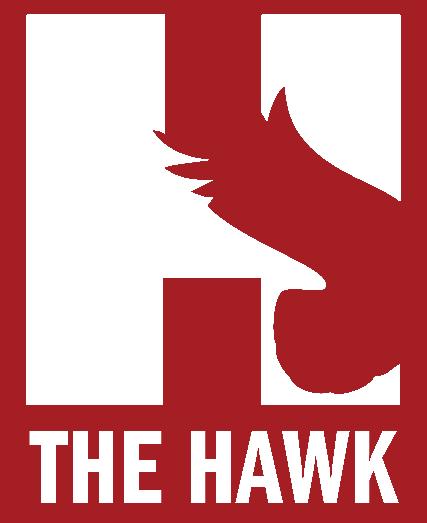
As of Sept. 21, there were 59,762 individuals in U.S. Immigration and Customs Enforcement detention, with over 70% having no prior criminal charges or convictions on record. As detention and deportations continue, the The United States Conference of Catholic Bishops has called for “meaningful immigration reform.” The statement condemned the ‘vilification of immigrants,” expressed concern about conditions in detention centers and affirmed the “fundamental dignity of all persons.”
Catholic Social Teaching puts forth three basic principles that summarize the church’s position on immigration policy, all of which reflect Catholic ideals of compassion and respect. The Trump administration’s immigration policies — like mass deportations — do not align with the Catholic social teaching, which states that although a nation has the right to regulate its borders, this must be done with “justice and mercy” and recognize people’s
right to migrate to sustain their lives.
In a letter addressed to American bishops, the late Pope Francis expanded on the Catholic Church’s opposition to deportation policies from a Jesuit
“All people have human dignity and are worthy of compassion, no matter what side of a border they’re on.”
perspective. Francis urged Christians to consider the importance of human dignity when reflecting on the ethics of immigration policy. Deporting individuals who left their homes to escape poverty,
persecution or environmental decline disregards the dignity of the human person and subjects them to vulnerability and despair. Francis calls up “the faithful of the Catholic Church” to oppose this practice, as Christians are called to live in solidarity with one another and seek the betterment of all lives.
The U.S.’s current immigration policy fails to acknowledge the humanity of all humans. The Catholic Church’s teachings and public statements serve as valuable reminders of the morality issues inextricably linked with deportation. Immigration must become less politicized; all people have human dignity and are worthy of compassion, no matter what side of a border they’re on.
The Hawk welcomes Letters to the Editor, typically no more than 250 words. They can be emailed to hawk.editorial@gmail.com.
Corrections: In the Nov. 12 issue of The Hawk, the infographic “First-gen Fact Box” incorrectly reported the title of Elizabeth Lee, Ph.D., as faculty liaison for first-generation and low income students. Lee’s title is Inclusive Excellence faculty liaison.

GRACE HELLER ’26 Guest Columnist

The federal government surpassed its record of 35 days for the longest government shutdown Nov 5., but Pennsylvania’s government hadn’t fared much better, as the commonwealth’s budget was over 130 days late. This caused some schools to wonder whether they could remain operational in January.
Before these school districts’ concerns were raised, Governor Josh Shapiro advocated in March for a budget that sent an “additional $494 million to schools deemed chronically underfunded and another $32 million to districts with high property tax burdens.” However, a budget impasse was foreshadowed when Republican legislators disputed the fairness of Shapiro’s proposed budget that clarified only a portion of school districts would receive money, as
determined by financial need. Similarly, Republicans pushed back on the suggested conditions for what was considered an “acceptable level” of service from school districts despite the fact rural districts would also receive additional funding.
Tensions over educational spending came at time when the Commonwealth Court ruled in 2023 that Pennsylvania’s system of funding kindergarten through 12th grade violated the Commonwealth’s constitution. The presiding judge wrote, “‘Students attending low-wealth districts are being deprived of equal protection of law,’” with compliance requiring equitable education funding. In response, 2024-2025 school year education spending increased by $1.1 billion, but, now, Republican legislators have since been vocal about limiting spending. Surprisingly, however, the long-awaited budget fully funds the adequacy and equity payments needed to fulfill Pennsylvania’s constitutional obligation.
Nevertheless, while it is OK to breathe
a sigh of relief, people should survey the damage; a number of Pennsylvania public schools have incurred costly loans to remain open — not to mention the harm to many others created by the federal shutdown. Thus, the current moment should be one of reflection for voters to remember. Though politicians can be unpredictable, we can vote them out, call them and organize
peacefully to show them that an over 30-day federal shutdown and a 130-day late budget are unacceptable. Only together, through compromise and compassion, can we stop our state and federal governments from struggling like this. We have a republic only if “[we] can keep it.”
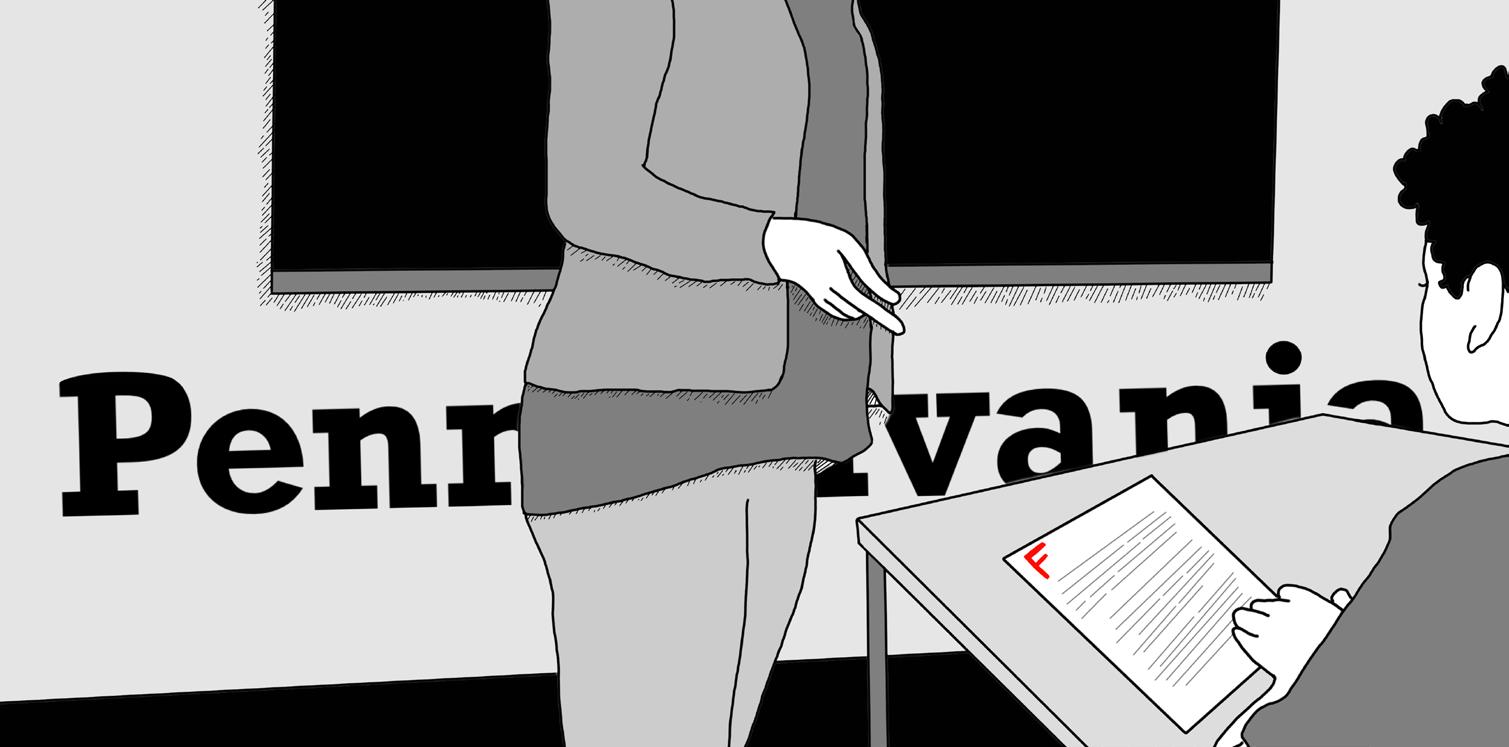
SAHR KARIMU ’26
Hawk Columnist

America’s youth is becoming illiterate. Earlier this year, the National Center for Education Statistics released another year’s edition of the Nation’s Report Card. This report evaluates the performance of students in fourth, eighth and 12th grade in subject areas including math, science, civics, reading and writing. Reading results this year were poor. Samantha Laine Perfas, staff writer for the Harvard Gazette, introduced a podcast episode of Harvard Thinking with these chilling words: “This month, average reading scores for high school seniors … fell to their lowest level since 1992.”
When this report reached headlines, I attributed this decline to lingering effects of the covid-19 pandemic. This attribution was a poor guess. The report indicates this is a trend accelerated by the pandemic
rather than caused by it. Data on fourth grade reading scores indicate results have been declining as early as 2015 and 2016 for students all over the percentile distribution. Students in eighth grade showed a peak around 2013 and then a steady aggregate decline, with some bucking reflected in the data.
These statistics may point to any number of underlying issues. Perhaps students are falling out of love with literature, perhaps phones are frying students’ minds or perhaps frightening economic outlooks are pushing students to pursue financially sound STEM degrees. Perhaps it is a mixture of all of those things. Whatever symptoms may be the cause, the diagnosis — a breakup with the page — is frightening. As Mr. Keating, Robin Williams’ character in the film, “Dead Poets Society,” puts it, “We read and write poetry because we are members of the human race. And the human race is filled with passion … But poetry, beauty, romance, love, these are what we stay alive for.”
If Mr. Keating is correct, and I believe he is, we must do something to reinvigorate reading. This is a call to you, St. Joe’s student body: Whether you have younger siblings, children, nephews or nieces, let us be present to help them see that literature, art — these

The absurd combination that now defines US foreign policy
JOHN PAUL HIEATT ’26 Guest Columnist

Recently, President Donald Trump made an announcement about possible military intervention in Nigeria to protect the country’s Christian population from persecution. In reality, the massacres are carried out by extremist groups like Boko Haram, not the Nigerian government. Furthermore, even in those attacks, Christians are not the only ones targeted: Anybody who stands in the way of an Islamic caliphate, including Muslims, are in their crosshairs. But that aside, what happened to “America First?” I guess maybe, for the sake of argument, we will just have to accept that under this new God-fearing administration, Christians are an exception to the rule for humanitarian interventionism. But wait. Then why isn’t Trump punishing Russia for massacring scores of civilians
in Ukraine (many of whom are also Christian) and closing their churches in Russian-occupied territory? And why did Trump reignite relations with the new Islamist government in Syria, even though Syrian Christians are not only being persecuted under the regime but are also victims of attack by the regime’s security forces and aligned militants?
The reality of this situation is, the “Christian genocide” in Nigeria is not real. Intervening in Nigeria would by no means be strategic for the U.S., either. If anything, it would possibly push Nigeria into China’s orbit; yet we still threaten to invade them. But when there is an actual existing case where Russia, a strategic adversary, is persecuting Ukrainian Christians — or another real-world example where Syria, an Islamist state with ties to al-Qaeda, is complicit in the persecution of Syrian Christians — we try to normalize relations with them? And perhaps the most shameless example of
this pseudo-humanitarian hypocrisy is that Trump was accused of considering ethnic cleansing himself, that being the expulsion of two million Palestinians from Gaza so the U.S. could turn it into a luxury resort.
Trump’s foreign policy is not pragmatic, it’s not humanitarian and it’s not values-based. It’s incoherent nonsense of an old man treating international relations like a toy to play with when he’s bored. This isn’t just a bad foreign policy; it’s a complete lack of one.

networking may not be what you think
real value of
OLIVIA LUTZ ’26 Columnist


The real power of professional gatherings isn’t about collecting business cards or expanding LinkedIn connections. It’s about fundamentally reshaping how we access knowledge, opportunity and influence within our industries. Forbes research shows successful professionals build strategic relationship portfolios rather than simply maximize contact lists. Consider how industry symposiums create unexpected collaborations — partnerships that emerge not from planned networking sessions but from spontaneous hallway conversations and shared elevator rides.
In professional development, this transformation is already evident. Julia Palmer, CEO and founder of RELATUS,
describes “sustainable relationship ecosystems,” in which professionals move beyond transactional networking to activate dormant connections and build relationship capital. These individuals attend conferences not to collect contacts but to create connections that compound over time, turning everyday interactions into measurable returns.
A recent study of undergraduate research symposium participants showed that those who engaged with professional gatherings exhibited significantly higher confidence and belief in their abilities, with researchers noting transformed perceptions and career resilience among attendees in comparison to non-participants. The findings suggest intentional symposium participation creates lasting professional advantages beyond immediate networking gains.
The physical presence at conferences
creates environments where interactions lead to unexpected breakthroughs. These moments rarely appear in online conferences. They occur during poster sessions, shared meals and those brief exchanges that feel insignificant in the moment but spark collaborations that define careers.
The professionals who will define the next decade aren’t asking, “How many contacts can I make?” They’re asking, “What collaborative value can we create when diverse expertise intersects at these gatherings?” This shift in mindset from quantity-focused collection to quality-driven cultivation will separate tomorrow’s industry leaders from today’s business card collectors.
As we enter an increasingly connected economy, the challenge facing every professional isn’t about whether conferences and symposiums matter for career
advancement. It’s about whether individuals will proactively architect meaningful professional relationships or simply react to opportunities created by more intentional networkers.

CAROLINE TRIMBLE ’26
Assistant Opinions Editor

When I was 18, I was formally diagnosed with ADHD. This was something my parents and I suspected beforehand, but since I did well in school, the diagnosis wasn’t something we thought to pursue before college. However, what we did not realize is, attention-deficit/hyperactivity disorder is responsible for so much more than just inattention and restlessness; there are a number of disorders connected to ADHD,
many of which are more detrimental than the traits most commonly associated with the neurotype.
One such disorder is rejection sensitivity dysphoria, an intense emotional reaction to rejection, criticism and disapproval. Those afflicted with RSD are often easily embarrassed, have low self-esteem and “people please” to avoid disappointing others. RSD can also lead to intense bouts of depression, as emotions can be too intense to comprehend or communicate, ultimately drowning individuals in shame, guilt and sadness that’s not easily shaken.
RSD is debilitating. I walk across
campus in fear, constantly terrified of others forming negative conclusions about me. I avoid participating in class unless I am completely sure of myself, as there is nothing worse than the thought of being corrected in front of my peers. Even reaching out to friends to make plans is challenging; any reply other than ‘Yes’ feels like a personal attack, reinforcing my belief that I am not worthy of having relationships.
While my ADHD symptoms can be mitigated by medication, there is not a pill that fixes RSD. My sense of self will always be warped. I will continue to expect that those around me are disappointed, and
there will always be days that I cannot get out of bed due to social concerns. Yet, I have found that through communication, the symptoms of RSD can be mitigated. Those who truly care about you will understand and respond accordingly to your emotional differences, and those who don’t will discard your words and watch as you decline. As hard as that rejection may be, those who choose to stay serve as a much-needed reminder that you are worth more than you know.
Creative Director

Growing up, video games were a staple in my household. Couldn’t go outside due to the weather? Play video games. Had friends over? Hold a tournament in a game like Super Smash Bros. It was the creative aspects of these games that served as core memories in my childhood.
As gaming companies begin to bring back classics as remastered games like the Mortal Kombat: Legacy Kollection and Marvel vs. Capcom Fighting Collection: Arcade Classics, I wonder if these companies are more focused on making a profit than on the creative aspects of the video games I grew up with.
When I was a child, most video games had their own unique spin to them.
Sometimes, it would be a unique art style, as shown in the character designs in the Kingdom Hearts and Castlevania series. Other times, it was unique game mechanics like Warner Bro.’s Nemesis system or the fast-paced hack-and-slash genre of Ninja Gaiden.
However, a lot of these unique qualities began to fade away with time. Most modern games include additional content, cosmetic items or even a whole portion of the story’s plot as downloadable content consumers need to buy in addition to the base game’s price. One example is Street Fighter V’s character roster, where roughly two-thirds of the available characters are blocked by a paywall. While profit is important, is the trade-off worth it?
This issue isn’t limited to the gaming industry, since it can be seen in the entirety of the entertainment industry. Examples include the celebrity casting of the new “Street Fighter” movie or the
rushed animation of One Punch Man’s third season. Creative and risky decisions have paid off before, like in the use of animation and different art styles in Sony’s Spider-Man: Into the Spider-Verse and Spider-Man: Across the Spider-Verse movies. So why get rid of the creative aspect of video games and other media that made them so memorable and loved by so many in the first place?

‘It really represents the permanent location for Asian Studies in our community’
BRYAN BALMORES-JUMARANG ’27 Features Reporter
As community members enter the second floor of the Frances M. Maguire Art Museum, they are greeted with a gallery showcasing 20th century Japanese woodblock prints, Indonesian shadow puppets and Tibetan Buddhist thangka paintings. These art pieces are part of the museum’s first permanent Asian Art Gallery.
The Maguire Art Museum, in collaboration with the Nealis Program in Asian Studies, held an opening reception Nov. 14. For Amber Abbas, Ph.D., associate professor of history and director of the Nealis Program, the gallery represents a permanent location for Asian Studies in the St. Joe’s community.
“My goal as director has always been to use the Asian Studies Program to create connections throughout the institution and the community, and the events that we’ve hosted in the last few years have really highlighted that… To have the gallery as a permanent manifestation of the work that
we’ve done really shows that it matters to us,” Abbas said.
The Asian Art Gallery is not just for visitors and students but also for faculty to incorporate into their curriculums, said Jane Allen, education and community engagement coordinator of the Maguire Art Museum.
“The other really important part to us is that this gallery is able to be used as a teaching gallery, and so faculty can come use it when they’re talking about history or art or Asian cultures in any way,” Allen said.
In the Great Hall, there was a ceremonial sweeping away of a sand medicine mandala, a ritual gesture encompassing impermanence, an integral Buddhist virtue. It was led by Tibetan artist Losang Samten, who spent the week at St. Joe’s constructing the mandela. Sand mandalas are an ancient and sacred Tibetan art form using colored sand, which symbolizes not just impermanence but spiritual healing and purification.
The Buddhist ritual is something that students like David Soler ’26, an Asian Studies student worker, resonate with their education.

“This semester, the Asian Studies Program has been covering this topic of health, healing in the body in Asia,” Soler said. “Seeing a healing mandala being brought to life definitely connects with all that we’ve been working [on] this semester.”
Further, the Asian Art Gallery represents “globalization” to Soler, as he looks forward to seeing cultures become more alive on campus.
“Being able to see all of this new Asian representation that’s coming in through all these really creative and really cool ways is really exciting to see and really cool to be a part of,” Soler said. “It really just shows that St. Joseph’s is progressing more and more every day and being in touch with those Jesuit values that they always talk about so proudly.”
To other students like Owen Monson ’28, the art exhibit represents the growth of the Asian Studies Program.
“It really does represent the growth of the study of Asia, of its cultures, its people, even questions of, ‘What is this identity and what we can learn from it?’” Monson said.
“The artifacts that are up there really do resonate with how culturally diverse it is.”
The diverse and “interconnected” nature of the Asian continent, Abbas said, is reflected through the collaboration of many different programs at St. Joe’s.
“The collaboration that we do here in the university between the Asian Studies Program, the museum, other departments, institutions, programs, it’s the way Asia has always been,” Abbas said. “To me, it’s fundamental. It’s not special work. It’s just our work.”
Abbas said the Asian Art Gallery not only allows connections between cultures but also reflects a greater representation of students of Asian descent at St. Joe’s.
“I think, especially now that it’s been a couple of years since our mergers with USciences and PA College, that we have a greater representation of students with Asian heritage on our campus,” Abbas said. “So, it also allows us, as a predominantly white university, to create those connections, and that’s incredibly important.”

A regional recap: Top 5 local roller coasters
Wildcat’s Revenge
Hersheypark
This year’s list of must-ride coasters looks notably different. The 2024 merger of Six Flags and Cedar Fair into the Six Flags Entertainment Corporation brought new management to Six Flags Great Adventure, leading to the removal of Kingda Ka and Green Lantern. Despite these losses, the area still boasts five exceptional coasters worth experiencing. As parks in the region start to close their doors to end the 2025 season, here are the top 5 roller coasters in the region for a last-minute ride.
El Toro
Six Flags Great Adventure
This Intamin prefabricated wooden roller coaster, built in 2006, is consistently ranked among the best roller coasters in the world. This year, the Golden Ticket Awards ranked El Toro No. 3 in best wooden roller coasters.
This ride stands at 181 feet tall, features a 176-foot drop, and a max speed of 70 mph. The attraction provides many points of ejector airtime moments, especially when crossing over the former Rolling Thunder track. Even though the coaster is starting to show its age, nearing its 20th season, the prefabricated track resembles the smoothness of a steel roller coaster, unlike a regularly built wooden roller coaster.
Six Flags Great Adventure has announced they will fully re-track the ride in the upcoming offseason to bring it back to the smoothness of its opening day form.
Another ejector airtime machine, Wildcat’s Revenge is Hersheypark’s newest roller coaster, created by Rocky Mountain Construction in 2023 as a reimagined version of the former Wildcat wooden roller coaster.
It retains preexisting wood for the structure and rides on RMC’s I-Box steel track. The coaster stands at a height of 140 feet tall with a 135-foot drop and a top speed of 62 mph.
RMC is known for reimagining old wooden coasters by adding smooth, unique elements, such as the sideways airtime hills or a zero-g stall. Elements like this make the coaster one-of-a-kind, while costing less than building a ground-up coaster. It is a must-ride at Hersheypark.
Nitro
Six Flags Great Adventure
Built during the height of Six Flags’ investment in the late 1990s and early 2000s, this hypercoaster remains a guest favorite at Great Adventure.
This coaster stands at a height of 230 feet, features a 215-foot drop and has a max speed of 80 mph. Its long, L-shaped layout with large drops and an upward spiral ends with small, powerful airtime hills.
The coaster has one of the best hypercoaster layouts ride manufacturer Bolliger & Mabillard has designed. Nitro is smooth and speedy and even has a floater airtime feature — which is especially impressive as the ride is approaching its 25th year at the park.
Hydra
Dorney Park & Wildwater Kingdom
Definitely one of the more unique coasters on this list, this Bolliger & Mabillard floorless coaster starts with an unconventional zero-g roll right out of the station, delivering a remarkable hang time moment.
This coaster stands at a height of 95 feet, features a 105-foot drop and has a max speed of 53 mph, with a total of seven unique inversions. The attraction recently celebrated its 25th year, and although it is on the rough side for its age and has a unique layout, it is a must-ride in the park.
Talon
Dorney Park & Wildwater Kingdom
Despite nearing 25 years old, this
inverted coaster remains impressively smooth. Built by Bolliger & Mabillard, Talon stands at a height of 135 feet. The coaster features a 120-foot drop and a top speed of 58 mph, delivering faster-paced, intense inversions.
With many rides of this model being similar in the Six Flags chain, this ride has a different layout that keeps a great pace, especially with the surprisingly intense second half. The layout features an unexpected airtime from a sharp drop into a low ground turn around, followed by an intense corkscrew. With all that intensity, you just can’t beat how unbelievably smooth the coaster is.

Riverside Pizza Address: 4217 Main St., Philadelphia, PA 19127
The chicken Caesar wrap may not have as clear of an origin story as the Caesar salad — first created in Tijuana, Mexico, in 1924 by an Italian-American chef — but it has cemented itself as a staple comfort food among college students.
The wrap shares a lot of the salad’s classic ingredients: chicken, crispy romaine, Parmesan cheese and a creamy Caesar dressing. The difference, of course, is that they come tucked inside a flour tortilla.
Fortunately, there are a lot of options near Hawk Hill. So, whether you’re craving something warm and hearty or lighter and fresher, these spots will not disappoint.
Rock Hill Pizzeria
Address: 214 Rock Hill Road, Bala Cynwyd, PA 19004
Price: $12.49
The chicken Caesar wrap from Rock Hill Pizzeria comes in a warm, pressed tortilla filled with a generous amount of chicken and is accompanied by a side of french fries. The large dose of chicken makes it a heavier wrap, but it is perfect for anyone craving a filling lunch between or after classes. Each bite is meaty and rich. The warm tortilla adds a nice crunch, too.
The main drawback? The flavor can be quite overpowering. The generous amount of Caesar is strong and makes the wrap too creamy.
Still, if you are hungry and want a nice, warm chicken Caesar wrap to eat without having to go far from campus, check out Rock Hill Pizzeria. It isn’t the lightest or freshest wrap you can get, but it satisfies in size and comfort. Try asking for less dressing.
Price: $13.15
Riverside Pizza is just 15 minutes from campus. They offer a chicken Caesar wrap that stands out for being light, balanced in flavor and tightly wrapped. Grilled chicken, lettuce, provolone and Caesar dressing are evenly distributed throughout — nothing is too overpowering in this wrap.
Paul Kletzel, an employee at Riverside, said that balance is what makes the wrap so good.
“Not one flavor overpowers the other, so you can taste the Caesar while still tasting the seasoning on the chicken without it being overpowering,” Kletzel said.
For students needing a quick, nice-quality lunch, Riverside is an ideal choice. Nicely rolled to limit mess, this wrap is more sophisticated in flavor compared to others and a perfect fit for a mid-day pick-me-up lunch.
Goodness Bowls
Address: 650 Montgomery Ave., Suite 130, Narberth, PA 19072
Price: $13.99
Just six minutes from campus, Goodness Bowls brings a healthier option to the chicken Caesar with its Avo-Caesar Wrap. While the name is different, it still has all the classic ingredients, such as romaine, chicken, shaved Parmesan and Caesar dressing, but it also has bonus ingredients, such as avocado, lemon juice and hemp seeds. It hits lighter than what is offered at nearby pizza shops.
Alyssa Smith, Goodness Bowls manager, said the wrap’s unique ingredients make it stand out.
“We add avocado, which I feel a lot of
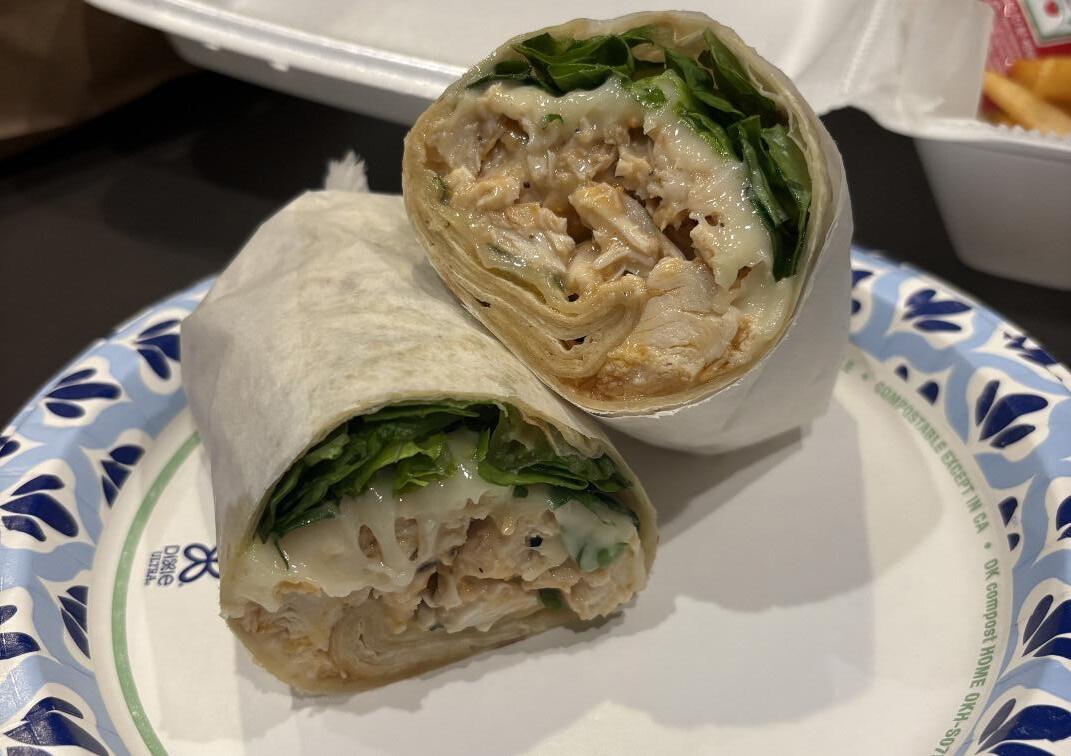
people don’t really do, and we use a lot of fresh produce and ingredients in our wraps,” Smith said.
The Narberth location opened in March and has already become a favorite spot for St. Joe’s students looking for something quick and healthy. The ingredients taste clean and balanced, with every bite offering creamy avocado, a hint of lemon and crisp romaine.
Plus, they’re a good deal.
“They’re nice size wraps,” Smith said. “You get a big bang for your buck, and it fills you up.”
Hawk Wrap
5600 City Line Ave., Philadelphia, PA 19131
Price: $7.19
Hawk Wrap is located right on campus
OLIVIA GASPARRO ’27
Features Reporter

Food influencer and critic Keith Lee is using his TikTok platform of nearly 18 million followers as a call to action for companies and community members to partner with him in giving away meals during the holiday season.
Brands such as DoorDash, Idahoan Foods, Drip Drop Hydration and Sweet Thangs New Orleans are among the many that have expressed interest in supporting his initiative.
Lee posted on his page encouraging others to join him in donating meals to those who are battling food insecurity — particularly those who have been affected by the recent government shutdown, causing 42 million SNAP recipients to struggle to put food on their tables.
For Lee, this initiative is not about the brand partnerships. It’s about being able to help the families being impacted.
“I want this to be specifically about the families we feeding and the holidays that we making holidays … It’s about their holidays,” Lee shared in a TikTok video. “And we want to make sure that we are supporting the families in this holiday. So, if you are a brand and you want to be a part of it, I’ll see you in the comments. God bless you.”
Lee’s career
Before becoming a beloved food reviewer online, Lee was a Las Vegas-based
fighter.
Lee started posting general content in 2020 documenting his life and cooking for his wife, Ronni, sparking the mainstream interest that would eventually grow his platform. What started as simple cooking videos evolved into taste tests of snacks, then chain restaurant dishes and ultimately full restaurant reviews by 2022.
Lee’s content is simple and straightforward: He visits a restaurant, tries their food and gives it an honest rating.
His reviews have helped stop businesses from shutting down, and, according to Rolling Stone, have even “spun a city’s food scene into complete turmoil in less than two videos.”
While Lee is proud of the platform he has made, he doesn’t want to be known as a celebrity.
“‘I think fame and celebrity are what you make of it,” Lee shared with Rolling Stone. “And if I accept the title ‘celebrity,’ then I’ll have to accept whatever else you put on me. I’m a human being. I’m a person. I’m not somebody famous. I’m not an influencer. I’m Keith. And I eat food.’”
Personal connection
On his page, Lee has been open about his struggles with anxiety and depression. Lee explained he was managing his mental health struggles by preparing meals and distributing food to those in need. He has also been candid about the financial struggles he faced while trying to do so.
“How was I buying that food to make meals for the less fortunate? On food stamps and gift cards that people was giving to me,” he shared in a TikTok.
Lee has used his platform to challenge the stigma surrounding those who receive SNAP benefits as well.
“I want to take this opportunity to say it’s not something that is uncommon or something crazy that has to occur for you to be in a situation where you need
inside The Drop at Campion through Hawk Dining Company’s Mobile Ordering service, so it is the most convenient spot to get a chicken Caesar wrap. The wrap includes lettuce, breaded chicken, grated cheese and Caesar dressing, all wrapped in a soft tortilla. The chicken is soft but has some crisp to it from the breading.
At only $7.19, it is a relatively cheap option compared to others. Plus, St. Joe’s students can pay using either meal exchange, Dining Dollars, Hawk Cash or a credit card. While the flavor is on the bland side, and it is on the flimsier side compared to off-campus spots, it is still good enough for a quick bite between classes.
SNAP or you need food stamp benefits. And I am a prime example of that,” he said in another TikTok video. “[When] my first and second daughters were born, we was on food stamps. And I vividly remember exactly what it felt like.”

LISBETH URENA ’27
Features Reporter
Preparing for study abroad is an equally nerve-wracking and exciting experience.
Before I left, I had so many questions: How do I prepare? What should I pack? What do I actually need to know?
While there’s no one-size-fits-all guide — every study abroad experience is unique — here are a couple of do’s and don’ts you should keep in mind before and during your experience.
Don’t overpack
Act as if you’re going on a trip for a few weeks and bring the essentials and some extra comforts. You’ll be able to stock up on basic toiletries and items while abroad. While you’re away, you’ll also be doing tons of shopping, so you’ll need some extra luggage room when packing to go back home.
Do stay open-minded
You’re going to a foreign country with different cultures, customs and foods than your own, so there are going to be things you’ve never seen or experienced before. It’s good to go into your study abroad knowing you’ll be trying new things.
Don’t slack on your classes
Life seems so unreal while you’re abroad — everything is exciting and moves quickly, making it easy to forget the main reason you’re there. It’s easy to get overwhelmed by classwork, so make

sure to pace yourself between trips.
Do explore your host country
You’ll want to take advantage of your close proximity to countries surrounding your host country, but don’t forget about the country you chose to live in. Take some time to explore your host country, and use your weekends to travel to different regions and learn about the culture.
Don’t be afraid to be vulnerable
Traveling across the world is a scary experience. Don’t be afraid to reach out to your family and friends for support, and lean on the people you surround yourself with while abroad. It was hard for me to leave my family behind, but calling them every day and surrounding myself with friends here helped me stay strong.
Do keep a journal
This will probably be one of the most memorable and meaningful experiences of your life. You’ll likely want something to look back on in the future and reminisce about. Make sure to get souvenirs as well: keychains, magnets, postcards, socks or something to collect to show where you’ve been.
I’m a month out from leaving Madrid to go back to the United States, and I already have a box full of mementos, keepsakes and gifts from my travels that I’ll be bringing back with me. My time here has already been so memorable, and I’m so sad it’ll be ending soon. I’ll definitely miss the culture and how different life is here in Spain compared to Philadelphia and the U.S.
BRENNAN DILLENBECK ’28
Hawk Staff

Across
1. Hawk ___ is the on-campus food and basic needs pantry, with two locations on the Hawk Hill campus, one on the University City campus and one on the Lancaster campus.
3. The element of community that permits people to feel like they have a say in how a community operates.
5. The members of this organization (acronym) have helped encourage the “Lost Cause” myth about the American Civil War, further politicizing history.
6. The last name of the evening keynote speaker, a retired Marine Staff Sergeant and LGBTQIA+ rights activist who advocated against the “Don’t Ask, Don’t Tell” policy.
8. The late Pope Francis’ encyclical on environmental justice.
9. Cuts to this food assistance program left 42 million Americans facing food insecurity.

CONNOR HOFFMAN ’26
Special to The Hawk
A 1933 issue of St. Joe’s long-running literary magazine, Crimson and Gray, offers an unexpected glimpse into what life was like for St. Joe’s students at that time.
“Hello Frosh!” a short story by Thomas B. Fitzpatrick ’35, imagines a conversation between a nervous first-year and a seasoned junior as they run into each other before class. Fitzpatrick’s story begins with small talk and shared cigarettes between the two students. The first-year inquires about clubs and academics, and the junior provides advice for how to best enjoy life at St. Joe’s, including getting involved in extracurriculars like Crimson & Gray and The Hawk Newspaper. He also suggests attending social events, such as the Junior Prom and the Freshman Tea Dance.
“I have enjoyed every moment of my stay at St. Joseph’s, but I have found that not many fellows get the best out of college life,” the junior tells the first-year. “Lots of them have the wrong attitude entirely.”
The 1933 edition of Crimson and Gray is part of the St. Joe’s Archives Collection, which contains every issue of the school’s literary magazine from 1919 to the present.
Ben Vanelli ’25, former co-editor of Crimson & Gray, said stories such as “Hello Frosh!” help readers understand the past through the eyes of a former student writer. The 2024 edition of the magazine, which Vanelli co-edited with Isaac Schwartz ’25, does the same.
“I hope that they are able to get a sense of the time that those students are in, whether it was in the aspect of the political climate or what was happening in the school, what was happening in the world,” Vanelli said.
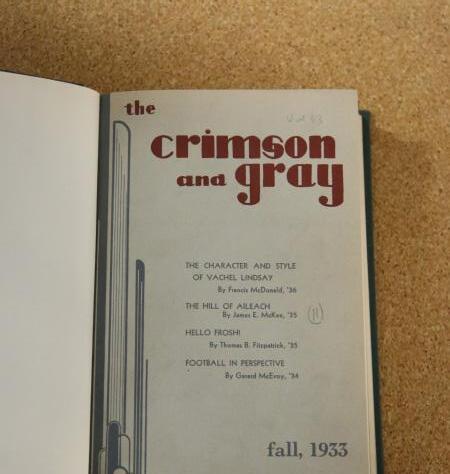
Down
1. Project ____ has built over 1,000 houses for unhoused people and provided over 26,000 healthcare visits.
2. A form of Buddhist art that is intricately designed and then immediately destroyed.
4. ______ House serves as a crisis hotline, home and site of advocacy for people experiencing domestic abuse.
7. ___ Yat-sen, first president of the Republic of China, and one prominent pan-Asianist.
NICOLE FRANZ ’27
Columnist

Philadelphia 76ers center
Joel Embiid is, once again, dealing with a health concern, only this time around, it’s his right knee. Embiid has had his fair share of injuries even prior to stepping on an NBA court — his earliest injury being a stress fracture in the navicular bone of his right foot just days before the 2014 NBA draft, where he was eventually selected as the third-overall pick by the Sixers. Now, just over 11 years later, Embiid is still facing setbacks as he attempts to effectively contribute to the Sixers’ success on a more frequent basis.
In February 2024, Embiid underwent a surgical procedure on his left knee to repair a torn lateral meniscus he suffered against the
Golden State Warriors. Embiid was able to return for the playoffs. However, he was not fully recovered, as the franchise’s star center evidently played through extreme knee discomfort on top of having Bell’s palsy, which primarily impacted the left side of his face. Embiid went on to join the USA Men’s National Team in the Paris Olympics that summer, where he contributed to the country’s fifth-straight gold medal. While fans hoped for their center to be healthy to start off the 2024-25 NBA season, Embiid’s season debut did not come until the second week of November.
Embiid was shut down for the remainder of the 2024-25 regular season Feb. 28 after appearing in just 19 games for the Sixers due to lingering knee complications. Key injuries and a lack of other available players such as Paul George and breakout rookie
Jared McCain contributed to the disastrous trajectory of the season, which assisted the medical staff and Embiid in their decision to address the knee issue earlier. Embiid ended the season with yet another knee procedure, only this time, it was minimally invasive. The arthroscopic knee procedure was used as an attempt to regulate the pain and swelling that Embiid had been dealing with from the culmination of the 2024 playoffs, the 2024 Olympics and the 2024-25 season. Embiid entered the 2025-26 season on a minutes restriction as a way to manage flareups of the left knee. This restriction includes refraining from playing in back-to-back games in order to monitor any swelling or pain. While Embiid has been performing well, it was announced Nov. 11 he would miss that night’s game against the Boston Celtics due to right knee soreness, which is not the knee that
has been the site of ongoing complications throughout his career. Following the team’s 102-100 home victory, the nerves of Sixers fans were calmed as head coach Nick Nurse said there were “no structural issues with Embiid’s knee and that he was day-to-day.”

JOSEPH MANCINI ’28 Sports Reporter
Carlin Warley ’95, a Philadelphia native, was one of the greatest to ever wear the St. Joe’s basketball uniform. A tough, skilled guard, Warley became a fan favorite in the early ’90s for his playmaking and ability to take over games. Now, his impact on Hawk Hill is being honored as he earns his place in immortality in the Big 5 Hall of Fame for the Class of 2025.
Warley’s career with St. Joe’s spanned from 1991 to 1995, where the team appeared in two National Invite Tournament postseason tournaments. Warley was a huge factor in those appearances, averaging 13 points per game in his career, with his peak performance in the 1993-94 season when he averaged 16.4 points per game. During his time at St. Joe’s, he remained a consistent player, dominating on all sides of the court.
His skill never went unnoticed by the league. Warley was named to three All-Atlantic-10 teams in 1992-93, 1993-94
and 1994-95, not only by his effect on the offensive side but the defensive as well. Warley ranked No. 1 in the A-10 for total rebounds in the 1993-94 with 318 rebounds and in the 1994-95 season with 309 rebounds. He was also No. 1 in the A-10 for rebounds per game in the 1991-92 with 9.0 rebounds, 1993-94 with 11.4 rebounds and 1994-95 seasons with 10.7 rebounds.
In his career with St. Joe’s, Warley appeared in 64 different top 20s across the A-10 and the NCAA in all different stats during his playing time.
Warley is enshrined in St. Joe’s basketball history as one of only four players to have 1,000 career points and rebounds. He remains on the top record books in the A-10, ranking sixth and seventh in the A-10 career rebounds lists and rebounds per game, respectively.
Warley will be honored along with five other inductees of the Class of 2025 in the Men’s Big 5 Classic Dec. 6 at Xfinity Mobile Arena and at the Women’s Big 5 Classic Dec. 7 at Finneran Pavilion.



Assistant Sports Editor
One year after fielding a team again, women’s club rugby is taking control of the pitch. Following a season of foundation building and ending the 2024 season with one victory, the Hawks have blanked out competition they previously fell to.
With a larger roster than last season, the Hawks ended the 2025 developmental season with multiple wins and tight finishes at the Mid-Atlantic Rugby Conference Nov. 8.
Head coach Greg Ebersole said the best satisfaction was seeing improvement as players “grew into their roles.” After assigning positions, Ebersole said the players worked hard to understand the game. The Hawks caught on quickly, allowing them to learn and compete in multiple positions.
“It’s easy with these girls because this year — specifically this semester — [they] put it all out there,” Ebersole said
Fourteen new players this season committed to three practices a week and
studying rugby terminology. The 27-player roster played multiple motley matches to gain competitive game day experience in the sport.
“At the end of the day, you want to win,” Ebersole said. “But more importantly, you want to see the players improve over the season. I think every player this season did that.”
First-year Noelle Santiago wanted to continue playing rugby after high school. Coming in with two years of experience, Santiago enjoys spending extra time with players and teaching them the game of rugby. Sharing these experiences not only strengthened the team but grew friendships.
“We’re all just there to help each other,” Santiago said.
Helping players out has extended beyond team lines. When going against teams without a complete roster, the Hawks have been quick to sub in for the opposing teams. During the St. Joe’s women’s rugby tournament Sept. 27, Santiago played a whole game as a sub for University of Pennsylvania. Santiago still, to this day,
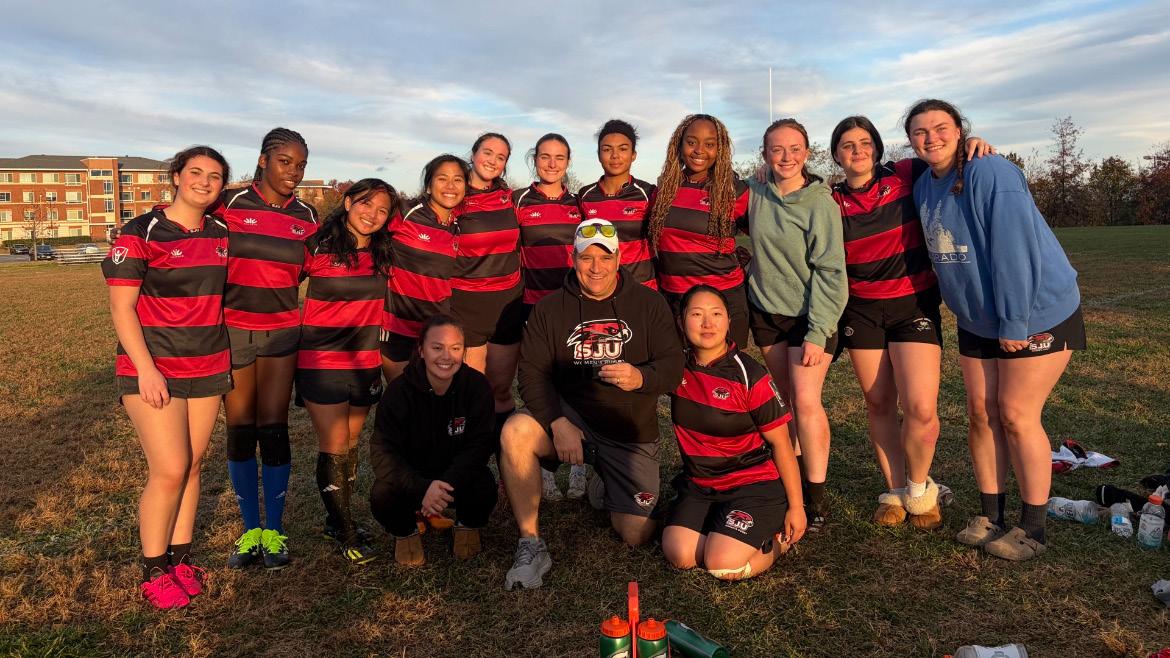
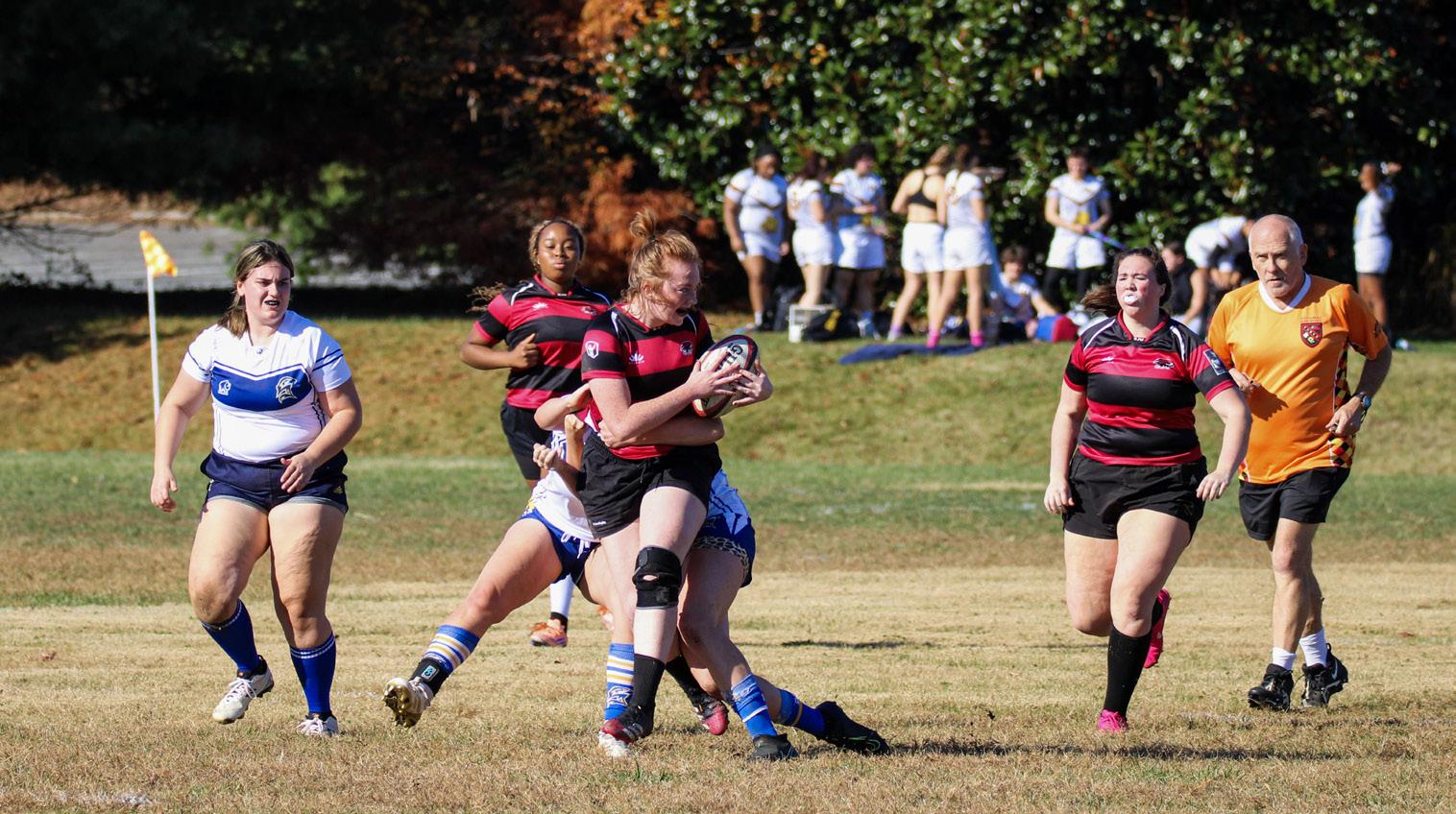
keeps in contact with the UPenn players.
“No matter what team, everyone is just so inclusive and accepting,” Santiago said. “You have to be because you’re literally putting your body on the line with these people.”
Senior Brianna Kelly, president and captain for the past two years, said players will “gladly step in” to sub for opposing teams.
“We used to be in that position where we were asking teams for girls,” Kelly said. “Because of how much it meant to us to receive those players, we wanted to give back to that rugby community.”
Even during tough games, the team continues to support one another.
Sophomore Bailey Kearns said the team has built a “wonderful community,” both on and off the field. With the majority of players in their first season, the team relied on each other to progress from game to game.
Santiago agreed the unity built through training and team bonding helped strengthen the group. After establishing strong relationships, the team broke down and analyzed games. This starting point
allowed the team to fine-tune formations and aggression with the ball.
The camaraderie was the “final push” to have a strong turnout at the Mid-Atlantic Rugby Conference, Kearns said.
“We realized that the most important aspect of this game is each other,” Kearns said. “So, we rely on each other to progress.”
After reflecting on building the team with senior Tess Margis from two to 27 players since the fall of 2023, Kelly couldn't be prouder. Kelly said she feels comfort in knowing that when her senior season comes to an end, there are girls who will grow the program.
“I know that I can trust them to carry it on because me and Tess were able to build a good foundation for these girls for the years to come,” Kelly said.
Tess Margis ’26 is an assistant sports editor on The Hawk.

ZANE O’ROURKE ’26
Special to The Hawk
Tailgating is a staple for Philadelphia sports fans. On game day, the lots surrounding Lincoln Financial Field are packed full of grills, coolers and enthusiasm from sunrise until kickoff. There is nothing like it — Eagles chants, music and games bring the city together around one team.
Not having a ticket doesn’t mean missing the game, though. It just means moving the tailgate indoors. The Linc, located right in South Philly, is within reach of plenty of fan-packed options to keep that tailgate energy alive. Here are three to check out.
Chickie’s & Pete’s
Address: 1526 Packer Ave., Philadelphia, PA 19145
An official partner of the Philadelphia Eagles, Chickie’s & Pete’s is one of the most famous Philly sports bars and is only a short
walk from the Linc.
Known for their Crabfries, you can expect crowded tables, beer buckets and nonstop Eagles chants on game day. Plus, anyone looking to save a few bucks can visit Chickie’s & Pete’s for $3 Miller Lite bottles from “whistle to whistle,” or from start to finish, during every Eagles game.
Megan Karpovich, a manager at Chickie’s & Pete’s, said the atmosphere on game days is just plain fun.
“I would say it’s a very silly sports bar,” Kaprovich said. “Just a great time overall.”
Sports & Social at Live! Casino & Hotel
Address: 900 Packer Ave., Philadelphia, PA 19148
Sports & Social prides itself on turning every Eagles game into what the venue calls a “title-worthy celebration.”


Just a few blocks from the Linc, Sports & Social allows you to continue your tailgate and catch all the gameday action live on their 52-foot LED screen and 24 TVs. During games, Eagles fans can be found here enjoying Bud Light beer towers, live DJs, giveaways and contests.
Located inside Live! Casino & Hotel, Sports & Social provides an exciting gameday experience with signature cocktails, themed drinks and an atmosphere that keeps Philly fans coming back game after game. Packed with green jerseys and Philly passion, Sports & Social makes fans feel like they’re a part of the action inside the stadium.
Stateside Live!
Address: 1100 Pattison Ave., Philadelphia, PA 19148
Right in the heart of the Stadium District, Stateside Live! is a fan favorite among Philly sports fans looking to keep that tailgate energy going once kick-off hits.
On gamedays, Stateside Live! is always
shoulder to shoulder, turning the entire place into an indoor tailgate. Inside, you can find multiple bars and food stands such as Lorenzo and Sons Pizza, Geno’s Steaks and many more, making it easy to grab a drink or a quick bite without having to miss a single play.
Stateside Live! also has a mechanical bull inside for fans looking to have a little extra fun. Plus, there is an outdoor patio for those who still want to experience the energy of the game but with a little more breathing room.
Jake Pleis, a lifelong Philly sports fan, said he gets bored watching the game at home. Stateside Live! is a great alternative.
“This place is just electric,” Pleis said. Whether you’re riding the bull, quenching your thirst or shouting out Eagles chants, Stateside Live! brings an energy that can’t be matched. They have earned their reputation as a premier spot to watch any Philly sports event live.
‘It only fuels them to want to work harder and achieve even more’
TESS MARGIS ’26
Assistant Sports Editor
Juniors Othman Bezzaz and Ernesto Ruy made St. Joe’s men’s tennis history by being the first doubles team to reach the semifinals of the Intercollegiate Tennis Association regionals and quarterfinals of ITA East Sectionals Championships Oct. 19 and Nov. 6, respectively.
The duo defeated 15th-seeded Columbia University 8-7 in a tiebreaker to reach the semifinals and won against fourth-seeded Clemson University 3-6, 6-3, 10-8 in a super tie-breaker to make the quarterfinals.
By beating University of Pennsylvania 8-7 in regionals to advance to the quarterfinals against Columbia, the duo automatically qualified for sectionals. Bezzaz said he was initially unaware they were the first Hawks to make that round and described the feeling as “surprised but happy at the same time.”
“After that win against UPenn, [head coach Jeff Puhan] told us, ‘You guys made history, and you qualified for sectionals,’” Bezzaz said. “We were, like, ‘Oh.’ I didn’t even know about it.”
Ruy described the experience as “different” after becoming accustomed to the team’s season ending after regionals.
“I was very happy to do good, and also very happy because after that, we realized what we can do and what we can achieve,” Ruy said.
Bezzaz and Ruy broke the previous record set in 2021 when Nickolas Frisk ’21, M.S. ’22, and Alp Sentay, M.S. ’22, made the
round of 16. Bezzaz said winning match after match built up their confidence.
“We were like, ‘Oh, we did something great,’ and then we just build up and think about how we can improve it for the next match,” Bezzaz said. “We still were able to beat some great teams, some top-ranked teams.”
Ruy credits their run to the support of his teammates, who hold themselves to high standards to win and work hard. He said the team is happy to watch each other win, and that being surrounded by positivity bolsters their success.
“If someone does good, we are very happy,” Ruy said. “If I do good, I’m happy. Othman is happy for me. That’s a very big support, to see that everyone is happy about your success.”
Ruy said the hard work was “exhausting,” but it was required of them to succeed.
“Everyone wants to win and to participate and work hard,” Ruy said. “Working hard in practice, if everyone works hard, everyone’s going to improve.”
Puhan said watching the duo was “gratifying” and that he knew they could accomplish more than what was expected of them.
“I’m thrilled to death that these guys are seeing success because it only fuels them to want to work harder and achieve even more,” Puhan said.
The pair ultimately lost to Penn 6-4, 7-6 in regionals and North Carolina 6-4, 6-2 in sectionals. Bezzaz said while they’re not happy with the outcome, they learned a lot from the matches and will
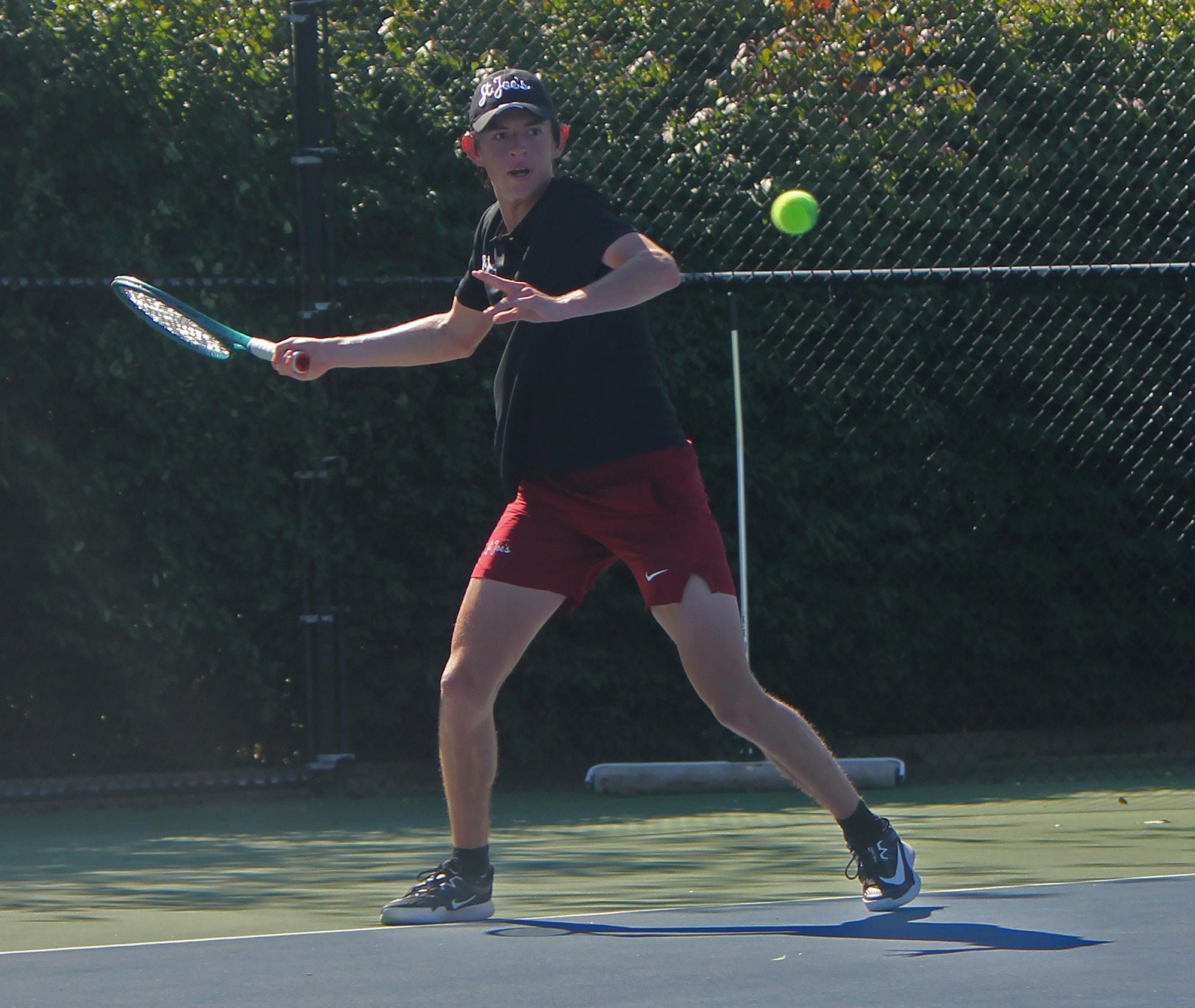
use the experience to prepare themselves for the spring season.
“[We were] disappointed, obviously, after the loss with UNC,” Bezzaz said.
“But we also had a discussion at the end of the match and tried to figure out some details that we should work on.”
Ruy echoed Bezzaz’s sentiment.
“Those small details that are going to make us win those matches in the future,
just work on those things and practice those things,” Ruy said.